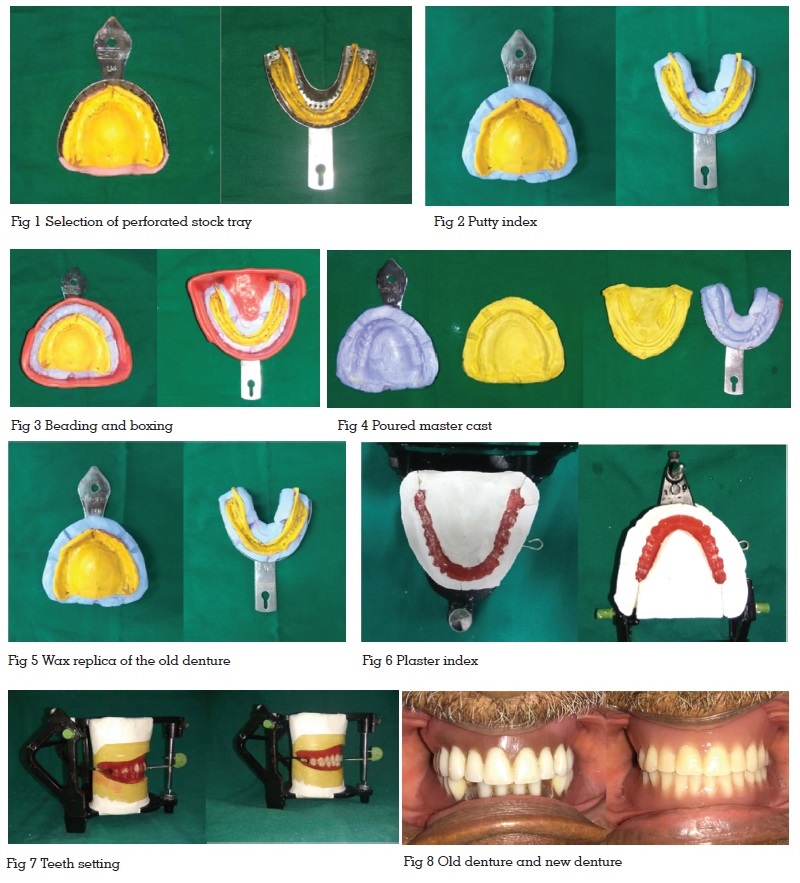

Many patients demands for a new denture which is exactly same as that of the old dentures. In such cases, the new dentures can be made by duplicating the old dentures. A simplified technique of fabrication of duplicate denture is described in this article. The tissue surface were simulated with light body impression material and the teeth and polished surface of the denture were simulated with putty impression material.
Key words: Complete denture, Denture duplication, Wax replica
Denture duplication is most appropriate when a patient is satisfied with theold denture but needs anew denture.1 These replica dentures may have many faults when evaluated by a dentist but the patient demands for a new denture which is identical to the old denture. If the arch form, jaw relations, and stability of the old denture is acceptable, then the denture duplication can be advised.1 Denture duplication should not be used to correct large deficiencies in arch form or vertical dimension greater than about 3 mm.1 Reproducing the teeth and contour of the polished surfaces of the old dentures in a new set of dentures aid in the rapid adaptation of the denture in patients especially with neuromuscular disorders.A variety of methods have been suggested for duplicating an existing complete dentures.1-9 In this article, we describe a simple technique of duplication of an existing complete denture.
A 67-year-old male with a complaint of ill fitting (loose) upper denture and lower denture with dislodged canine teeth was referred to the Department of Prosthodontics for prosthetic rehabilitation. The dental history revealed that the patient had been edentulous for approximately 5 year and was a denture wearer from past 5 years. On oral examination, well-formed edentulous upper and lower ridges were found. On evaluation, the maxillary denture was lacking adequate retention and missing canines in the lower denture. The patient demanded to get a new denture which is identical to that of his old denture with enhanced retention and stability.
In the first day of clinical visit, a functional impression was made using the old denture as the impression tray with light body impression material. Putty index was made for duplication the polished surface of the old denture. For the putty index two slightly large perforated stock trays were selected and putty impression material was placed in the tray. (Fig 1) The functional impressions were then immersed in the stock tray. When the putty material had set, locating grooves were placed on the putty index. (Fig 2) Cast were poured with type III dental stone after beading and boxing of the tray. (Fig 3) The set cast and the denture were retrieved from the putty index. (Fig 4)
Denture base was made using self-cure acrylic resin on the master cast. Wax replicas of the old denture were made by pouring wax on the space created by the old denture. The locating grooves were used to orient the master cast to the putty index. (Fig 5)
In the next appointment, jaw relation was recorded using the wax replica. It was then articulated and plaster index was made to aid in teeth setting. (Fig 6) Every other tooth is replaced initially, to help maintain arch form and tooth position. (Fig 7)
In the next appointment, trial insertion was done. The patient was thoroughly satisfied with the trial insertion. The denture was fabricated using the conventional method and the new denture was delivered to the patient in the next appointment. (Fig 8)
An easy and cost effective technique for duplication of the denture has been described. No special equipment are required. Aesthetics and function of the complete denture was achieved. The familiar features of the old dentures are retained in the new dentures. This method is particularly suited for elderly patients.